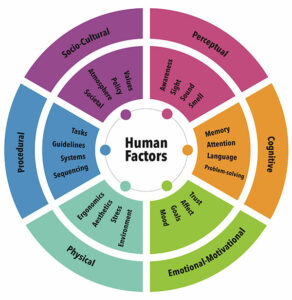People often ask us, “What are the most important human factors in healthcare?” Well, it depends. For handheld surgical tools, we focus on the biomechanics of the hand and the wrist, ensuring that the wrist is in a neutral position and that the fingers are not required to pinch for extended periods of time. On graphical user interfaces, we focus on perceptual issues such as how well the display can be seen, the legibility of the icons and text, and the grouping of display items. For instructions for use (IFU), we pay close attention to cognitive issues such as learning difficulty, nomenclature, and offloading memory.
This applies not only to healthcare human factors, but to the design of all kinds of products. No matter the product, however, we begin with an initial assessment of potential human factors concerns. We often start with the simple framework below. Like many models, it oversimplifies a complex phenomenon — namely, the way a person interacts with a product. Even so, it helps us to initially scope projects and direct our efforts. We hope you find it useful as well.

Perceptual Human Factors
Going top to bottom and left to right, we start with perceptual human factors. You will often hear the terms sensation and perception used together, so we will discuss their relationship first. Sensation delivers information from the environment to our sense organs. When we sense a stimulus, receptor cells inside our sensory organs (eyes, ears, skin, tongue, etc.) respond to energy in the environment. For vision, the stimulus is light, and for hearing, the stimulus is a change in air pressure. The sensory receptors then act as transducers, converting physical energy into neural activity.
Perception, on the other hand, takes this process to the next step, enabling us to recognize, interpret and make sense of the stimulus. When we perceive something, our brains organize the neural activity generated by our senses into meaningful patterns that we can interpret and recognize. To do that, we combine the sensory information with knowledge and expectations from long-term memory.
As a result, perceptual human factors problems can arise from a poor stimulus (small text, blurry image, poor contrast) or failing to meet our expectations (e.g., jargon rather than everyday terminology, illogical grouping, and inconsistent layout). Here are just a few things we look out for:
- Text size and contrast
- Text color
- Image sharpness
- Nomenclature
- Color combinations (some lead to blurriness and annoyance)
- Item placement
- Item grouping (people expect similar items and related items to be placed close together)
Cognitive Human Factors
Cognitive human factors are especially germane to healthcare. Cognition includes thinking, remembering, reasoning, and problem-solving – exactly what healthcare providers do all day long. The problem is that our ability to do these things is severely limited. For example, we can only pay attention to a small amount of information at once, and it’s difficult to think of two things at once. Worse, attempting to do more than this depletes our mental energy or what is referred to as our cognitive resources.
Neurons require a lot of energy and rest. When they work hard, we get fatigued and as a result, our thinking becomes more error-prone. Here are some cognitive human factors we pay attention to during our initial assessment of medical products:
- Information architecture
- Nomenclature (short, familiar, terms)
- How well do the most important items attract the user’s attention
- Is data presented to inform rather than overwhelm
- Attention switching (e.g., enabling side by side comparisons)
- Item placement (placing the most important information in the center 30° of visual field)
- Item organization (organizing items by importance, frequency, similarity, and co-occurrence)
- Chunking and categorization of information
- Likelihood of forgetting to conduct an activity (prospective memory)
- Proper use of analogy and metaphor
Emotion and Motivation
The words emotion and motivation derive from the same Greek word, “mot,” meaning to move. Emotions enable us to make a choice about whether to approach something or to avoid it. If we are attracted by positive emotions such as joy, curiosity, or anticipation, we approach or use the product. On the other hand, if we are annoyed, angered, or disgusted by a product, we avoid it. Not surprisingly, one job of healthcare human factors is to reduce negative emotions (at least in most cases) and capitalize on positive emotions.
Stress is a particularly important emotional consideration. Not only is stress often negative, but it tends to make us more error-prone. We tend to focus our attention to the exclusion of all other stimuli. We persevere in our use of problem-solving techniques that do not work, and our working memory capacity tends to decrease. As a result, our initial assessment places special emphasis on stress. Here are some other emotional and motivational issues that factor into our initial assessment:
- Valence: Does each interaction yield positive or negative emotions?
- Trust: Does the product promote trust in the user? Is there potential for the user to trust it too much (trust calibration)?
- Stress and anxiety: What tasks or system components are likely to cause stress?
Sociocultural Human Factors
Socio-cultural human factors refer to how well the design fits within the social and teamwork environment. For example, tools that have the potential to replace workers may be met with resistance. This is not a problem with the tool, per se, but is instead a problem with the effects the tool might have on the work environment. Other factors include teamwork and communication. For example, robotic-assisted surgery systems sometimes remove the surgeon from the sterile field, potentially making it more difficult for them to communicate with the rest of the surgical team.
Physical Human Factors
Physical human factors pertain to the size, shape, strength, flexibility and other factors of the product user. For example, in surgical environments, it is important that the largest person is able to fit, and the smallest person is able to reach. Given the variety of human shapes, sizes, strength, and flexibility, this is a difficult task. Here are a few factors we consider when assessing physical human factors:
- Static and dynamic anthropometry (size and shape of people when at rest and when moving)
- Reach envelope (placement of items in a workplace and how easy they are to reach)
- Size and shape of controls
- Actuation force
Procedural Issues
Sometimes the order or sequence of activities within a task just flows naturally. You know what to do next, and it just seems to make sense. Other times, you are confused about what you should be doing. These are some of the issues associated with the design of procedures. During the initial assessment, we often examine issues related to these procedures.
What Are the Most Important Human Factors in Healthcare?
So, you can see that one answer to the question about which healthcare human factor is most important is that it depends on the product. For different products, we emphasize different human factors. Another answer, however, is that there is no right answer. We must consider the person as a whole. Although it is convenient to break people down into components for analysis, in the end, people are much more than the sum of those parts, so everything must be considered.
We hope this detailed yet brief explanation of the most important human factors to consider when designing and testing products in the healthcare setting has proven useful. Furthermore, we hope to have shown the multiple aspects that must be taken into consideration, starting from the environment all the way to the user’s physical attributes.
Given the extensive knowledge and experience required to identify all of the human factors elements that need to be researched and addressed, it is highly beneficial to hire a human factors expert. We at Research Collective have a qualified team of human factors experts who can guide you through your next project and call out the most important human factors related to your specific device or interface.
Contact us to learn about how we can assist you in your next project.




